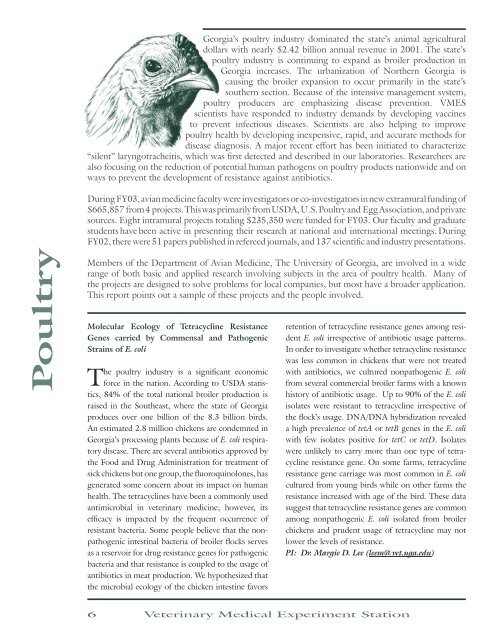Agroterrorism - University of Georgia College of Veterinary Medicine
Agroterrorism - University of Georgia College of Veterinary Medicine
Agroterrorism - University of Georgia College of Veterinary Medicine
- No tags were found...
Create successful ePaper yourself
Turn your PDF publications into a flip-book with our unique Google optimized e-Paper software.
<strong>Georgia</strong>’s poultry industry dominated the state’s animal agriculturaldollars with nearly $2.42 billion annual revenue in 2001. The state’spoultry industry is continuing to expand as broiler production in<strong>Georgia</strong> increases. The urbanization <strong>of</strong> Northern <strong>Georgia</strong> iscausing the broiler expansion to occur primarily in the state’ssouthern section. Because <strong>of</strong> the intensive management system,poultry producers are emphasizing disease prevention. VMESscientists have responded to industry demands by developing vaccinesto prevent infectious diseases. Scientists are also helping to improvepoultry health by developing inexpensive, rapid, and accurate methods fordisease diagnosis. A major recent effort has been initiated to characterize“silent” laryngotracheitis, which was first detected and described in our laboratories. Researchers arealso focusing on the reduction <strong>of</strong> potential human pathogens on poultry products nationwide and onways to prevent the development <strong>of</strong> resistance against antibiotics.During FY03, avian medicine faculty were investigators or co-investigators in new extramural funding <strong>of</strong>$665,857 from 4 projects. This was primarily from USDA, U.S. Poultry and Egg Association, and privatesources. Eight intramural projects totaling $235,350 were funded for FY03. Our faculty and graduatestudents have been active in presenting their research at national and international meetings. DuringFY02, there were 51 papers published in refereed journals, and 137 scientific and industry presentations.PoultryMembers <strong>of</strong> the Department <strong>of</strong> Avian <strong>Medicine</strong>, The <strong>University</strong> <strong>of</strong> <strong>Georgia</strong>, are involved in a widerange <strong>of</strong> both basic and applied research involving subjects in the area <strong>of</strong> poultry health. Many <strong>of</strong>the projects are designed to solve problems for local companies, but most have a broader application.This report points out a sample <strong>of</strong> these projects and the people involved.Molecular Ecology <strong>of</strong> Tetracycline ResistanceGenes carried by Commensal and PathogenicStrains <strong>of</strong> E. coliThe poultry industry is a significant economicforce in the nation. According to USDA statistics,84% <strong>of</strong> the total national broiler production israised in the Southeast, where the state <strong>of</strong> <strong>Georgia</strong>produces over one billion <strong>of</strong> the 8.3 billion birds.An estimated 2.8 million chickens are condemned in<strong>Georgia</strong>’s processing plants because <strong>of</strong> E. coli respiratorydisease. There are several antibiotics approved bythe Food and Drug Administration for treatment <strong>of</strong>sick chickens but one group, the fluoroquinolones, hasgenerated some concern about its impact on humanhealth. The tetracyclines have been a commonly usedantimicrobial in veterinary medicine; however, itsefficacy is impacted by the frequent occurrence <strong>of</strong>resistant bacteria. Some people believe that the nonpathogenicintestinal bacteria <strong>of</strong> broiler flocks servesas a reservoir for drug resistance genes for pathogenicbacteria and that resistance is coupled to the usage <strong>of</strong>antibiotics in meat production. We hypothesized thatthe microbial ecology <strong>of</strong> the chicken intestine favorsretention <strong>of</strong> tetracycline resistance genes among residentE. coli irrespective <strong>of</strong> antibiotic usage patterns.In order to investigate whether tetracycline resistancewas less common in chickens that were not treatedwith antibiotics, we cultured nonpathogenic E. colifrom several commercial broiler farms with a knownhistory <strong>of</strong> antibiotic usage. Up to 90% <strong>of</strong> the E. coliisolates were resistant to tetracycline irrespective <strong>of</strong>the flock’s usage. DNA/DNA hybridization revealeda high prevalence <strong>of</strong> tetA or tetB genes in the E. coliwith few isolates positive for tetC or tetD. Isolateswere unlikely to carry more than one type <strong>of</strong> tetracyclineresistance gene. On some farms, tetracyclineresistance gene carriage was most common in E. colicultured from young birds while on other farms theresistance increased with age <strong>of</strong> the bird. These datasuggest that tetracycline resistance genes are commonamong nonpathogenic E. coli isolated from broilerchickens and prudent usage <strong>of</strong> tetracycline may notlower the levels <strong>of</strong> resistance.PI: Dr. Margie D. Lee (leem@vet.uga.edu)6<strong>Veterinary</strong> Medical Experiment Station
















